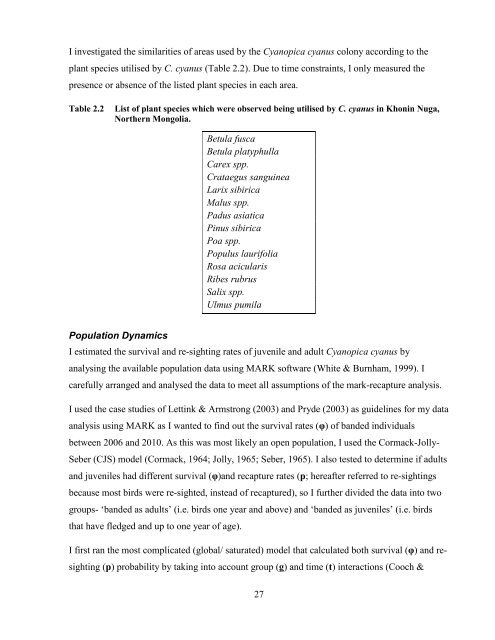Habitat use and population dynamics of the Azure-Winged Magpie ...
Habitat use and population dynamics of the Azure-Winged Magpie ...
Habitat use and population dynamics of the Azure-Winged Magpie ...
Create successful ePaper yourself
Turn your PDF publications into a flip-book with our unique Google optimized e-Paper software.
I investigated <strong>the</strong> similarities <strong>of</strong> areas <strong>use</strong>d by <strong>the</strong> Cyanopica cyanus colony according to <strong>the</strong><br />
plant species utilised by C. cyanus (Table 2.2). Due to time constraints, I only measured <strong>the</strong><br />
presence or absence <strong>of</strong> <strong>the</strong> listed plant species in each area.<br />
Table 2.2 List <strong>of</strong> plant species which were observed being utilised by C. cyanus in Khonin Nuga,<br />
Nor<strong>the</strong>rn Mongolia.<br />
Betula fusca<br />
Betula platyphulla<br />
Carex spp.<br />
Crataegus sanguinea<br />
Larix sibirica<br />
Malus spp.<br />
Padus asiatica<br />
Pinus sibirica<br />
Poa spp.<br />
Populus laurifolia<br />
Rosa acicularis<br />
Ribes rubrus<br />
Salix spp.<br />
Ulmus pumila<br />
Population Dynamics<br />
I estimated <strong>the</strong> survival <strong>and</strong> re-sighting rates <strong>of</strong> juvenile <strong>and</strong> adult Cyanopica cyanus by<br />
analysing <strong>the</strong> available <strong>population</strong> data using MARK s<strong>of</strong>tware (White & Burnham, 1999). I<br />
carefully arranged <strong>and</strong> analysed <strong>the</strong> data to meet all assumptions <strong>of</strong> <strong>the</strong> mark-recapture analysis.<br />
I <strong>use</strong>d <strong>the</strong> case studies <strong>of</strong> Lettink & Armstrong (2003) <strong>and</strong> Pryde (2003) as guidelines for my data<br />
analysis using MARK as I wanted to find out <strong>the</strong> survival rates (φ) <strong>of</strong> b<strong>and</strong>ed individuals<br />
between 2006 <strong>and</strong> 2010. As this was most likely an open <strong>population</strong>, I <strong>use</strong>d <strong>the</strong> Cormack-Jolly-<br />
Seber (CJS) model (Cormack, 1964; Jolly, 1965; Seber, 1965). I also tested to determine if adults<br />
<strong>and</strong> juveniles had different survival (φ)<strong>and</strong> recapture rates (p; hereafter referred to re-sightings<br />
beca<strong>use</strong> most birds were re-sighted, instead <strong>of</strong> recaptured), so I fur<strong>the</strong>r divided <strong>the</strong> data into two<br />
groups- ‘b<strong>and</strong>ed as adults’ (i.e. birds one year <strong>and</strong> above) <strong>and</strong> ‘b<strong>and</strong>ed as juveniles’ (i.e. birds<br />
that have fledged <strong>and</strong> up to one year <strong>of</strong> age).<br />
I first ran <strong>the</strong> most complicated (global/ saturated) model that calculated both survival (φ) <strong>and</strong> resighting<br />
(p) probability by taking into account group (g) <strong>and</strong> time (t) interactions (Cooch &<br />
27

















